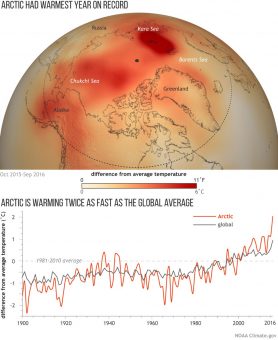
The Arctic broke multiple climate records and saw its highest temperatures ever recorded this year, according to the National Oceanic and Atmospheric Administration’s (NOAA) annual Arctic Report Card released Tuesday.
The report shows surface air temperature in September at the highest level since 1900 “by far” and the region set new monthly record highs in January, February, October and November. “The Arctic as a whole is warming at least twice as fast as the rest of the planet,” report author and NOAA climate scientist Jeremy Mathis told NPR.
Report Card Highlights:
-The average surface air temperature for the year ending September 2016 is by far the highest since 1900 and new monthly record highs were recorded for January, February, October and November 2016.
-After only modest changes from 2013-2015, minimum sea ice extent at the end of summer 2016 tied with 2007 for the second lowest in the satellite record, which started in 1979.
-Spring snow cover extent in the North American Arctic was the lowest in the satellite record, which started in 1967.
-In 37 years of Greenland ice sheet observations, only one year had earlier onset of spring melting than 2016.
-The Arctic Ocean is especially prone to ocean acidification, due to water temperatures that are colder than those further south. The short Arctic food chain leaves Arctic marine ecosystems vulnerable to ocean acidification events.
-Thawing permafrost releases carbon into the atmosphere, whereas greening tundra absorbs atmospheric carbon. Overall, tundra is presently releasing net carbon into the atmosphere.
-Small Arctic mammals, such as shrews, and their parasites, serve as indicators for present and historical environmental variability. -Newly acquired parasites indicate northward sifts of sub-Arctic species and increases in Arctic biodiversity.
Source: ecowatch.com

